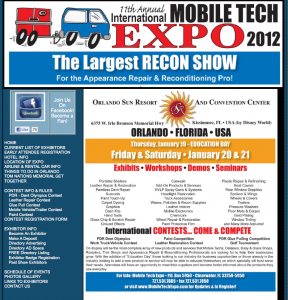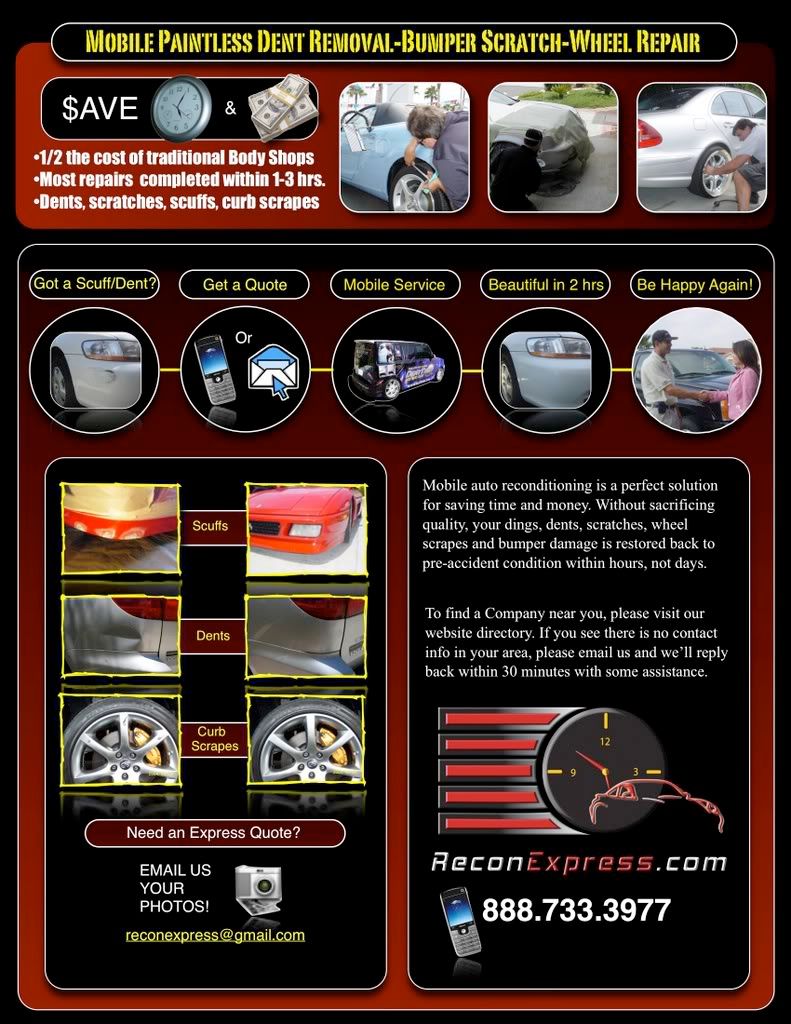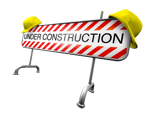 Ever heard of the Mobile Tech Expo? It’s an expo for the auto reconditioning pro. A must go show for anyone offering mobile repair and services. From paintless dent removal to mobile auto paint repairs.
Ever heard of the Mobile Tech Expo? It’s an expo for the auto reconditioning pro. A must go show for anyone offering mobile repair and services. From paintless dent removal to mobile auto paint repairs.
Posts Tagged ‘mobile bumper repair’
Mobile Tech Expo in Orlando 2012
Why Some Factory Bumpers Don’t Match – Mobile Bumper Repair
Facts On Bumper Color – Mobile Bumper / Scratch Paint Repair
This post is to inform the public why the factory original color of bumper and trim pieces may not match the rest of the vehicle from the start.
Causes of Color Variations:
#1 A color can vary depending on the substrate on which it is painted. For example, the evaporation rate for solvent varies over metal or plastic. A longer rate gives a flake pigment additional time to “float” and can darken the face of the color.
#2 The body was painted on a production line at the factory, while other parts, such as the bumper and trim were painted at another location using a different application method.
#3 Slight adjustments can be made during application creating a lighter or darker color, causing the metallics or mica elements to lay down differently.
#4 Light reflects differently on curved and flat surfaces causing the appearance of a color shift.
In conclusion, repainting a plastic bumper might have the same effects. Although mobile bumper repair in general matches paint back to factory specifications, it is possible on same repair cases, there would be a slight color shift. This commonly happens with paint colors such as; pearl white, silver and other 3 stage tri coats.
Please click here for more info regarding mobile plastic bumper repair and scratch repair.
Auto Body Shop Painters vs Mobile Auto Painters
Mobile Painters vs. Body Shop Painters
Body shops look at mobile painters as the enemy, stealing precious work away from them. But realizing the benefits these painters offer could change their perspectives.We found this post and thought we would share Tom’s point of view regarding the mobile painters vs body shop painters. One of the most important things he mentions is the business aspect of the job at the end of the article. Most business’ fail within the first 5 years, and 80% of them after that fail the next five years. Organization and a written business plan are key to keep your goals and priorities straight for success. Meanwhile, check out the post, we think you’ll find it interesting. post created by Tom Kronenwetter
 You’ve probably seen them painting bumpers and doors in a remote area behind dealerships. They come with their specially equipped mobile van or truck in the cold of winter and the heat of summer. They’re loved by used car managers and despised by body shop managers.
You’ve probably seen them painting bumpers and doors in a remote area behind dealerships. They come with their specially equipped mobile van or truck in the cold of winter and the heat of summer. They’re loved by used car managers and despised by body shop managers.
Who are they and how do they paint in such extreme weather conditions? Are they operating legally? Are they stealing business away from body shops? Is the quality of their work comparable with that of body shops? These are probably the questions that pop into the minds of body shop painters when they first see mobile painters.
Back in Time
Mobile paint repair technicians first appeared in the late 1980s when the collision repair industry was transitioning from lacquer-based paint systems to basecoat-clearcoat systems. They started as small, floundering franchise systems, most of which went bust early on. However, with the invention of HVLP turbines, this little niche industry took off in the mid-1990s and never looked back.
Mobile painters are usually part of a large, national franchise system that specializes in mobile paint repair. They have a large support network that keeps them legal, well trained, efficient and capable of performing high-quality repairs in weather conditions that would normally wreak havoc with the refinish process. Some mobile franchisers have monthly national sales of more than $2 million.
Mobile painters use the same paint materials as any conventional body shop; they just use them in a different manner because of the weather conditions. Their paint intermix systems are similar but on a smaller scale, and they use all the well-known paint systems. They all closely guard their trade secrets and proprietary methods that help them achieve quality results.
One of many differences, however, is how their spray guns shoot the paint materials compared with a spraybooth gun with unlimited psi at the ready. It’s like comparing a 12-gauge shotgun with a BB gun. A conventional spray gun may have 40 to 60 psi feeding the gun and about 65 percent transfer efficiency. The HVLP spray guns used in spraybooths have about 30 psi going into the gun, which still leaves enough psi to lay out the materials. Now to the BB gun. The 120-volt AC turbine HVLP has about 10 psi inlet pressure, which leaves about two psi at the tip of the gun. Doesn’t sound like much, right? Well, it isn’t, and learning how to paint with something as powerful as a spray gun can have its drawbacks. To a body shop painter, it would be equivalent to clearing a hood with a can of spray paint. It’s just not done.
The transfer efficiency of a turbine HVLP is usually better than 95 percent. That’s great for material costs, but the pressure difference can be quite noticeable when trying to lay out clearcoat. To make up for the lack of pressure, the mobile painter must use a slower pass and get very close to the panel when applying the clearcoat. Attempting this technique with a spraybooth gun would surely create a waterfall.
 I’ve seen spraybooth jobs I swore were painted outside and outside jobs I thought were done in a $500,000 spraybooth. The painter’s skill is always apparent in the finished product. Some of the small independent mobile painters have little if any formal training and give the mobile repair industry its reputation of being technically inferior to body shops. But many small body shops that lack quality control and training carry the same reputation.
I’ve seen spraybooth jobs I swore were painted outside and outside jobs I thought were done in a $500,000 spraybooth. The painter’s skill is always apparent in the finished product. Some of the small independent mobile painters have little if any formal training and give the mobile repair industry its reputation of being technically inferior to body shops. But many small body shops that lack quality control and training carry the same reputation.
The large mobile franchise systems, however, have extensive training and support systems that provide mobile painters with the latest technology to perform quality repairs outdoors. If their repair quality wasn’t comparable with that of most body shops, would the dealerships keep using them? It turns out that used car dealerships are competitive places and have to move cars off the lot fast. They can’t wait four days to get a bumper painted at a body shop. And body shops are busy places with large repair jobs that can’t afford to tie up booth time for a $150 bumper cover.
Down with the Enemy?
Often, body shops look at the mobile painters as the enemy, steal-ing precious work away from them. For a small or low-volume body shop, this argument may have merit. But for a large, dealership-owned body shop, the mobile repair service doesn’t present a severe threat to its profitability.
The mobile painter is an evil necessity to the used car manager and an annoyance to the body shop manager. A few years ago at a large dealership, some of the guys who worked at its body shop wired the outside 120-volt outlet for 220 volts. When the mobile tech arrived the next morning, the used car manager gave him a simple scratch job on a $50,000 Mercedes. The mobile painter plugged his buffer into the outlet as he had always done in the past and proceeded to buff out a scratch on the rear quarter panel with his foam pad. Ever see a foam pad run at 12,000 rpm? Smokin’! The incident was funny to the body shop guys but not to the mobile painter, who angrily confronted them.
The body shop manager was caught unaware of his mischievous painters’ prank and offered to repair the nine-inch bare metal circle on the quarter panel. The mobile painter appreciated the offer but said he would repair it on the condition that he be allowed to explain what his job was all about in order to ward off any future attacks. The flaming foam pad incident opened a dialogue between the mobile painter, body shop manager and the used car manager. Soon, it became apparent to the body shop manager that the mobile service was doing him a favor by performing speedy repairs that were desperately needed by the used car manager and couldn’t be duplicated in his shop.
There’s only so much real estate in a body shop, and finding another legal spray area for small jobs may not be an option. This is where a compromise can be found – outside rather than inside. Looked at it this way, body shops can be swayed from thinking that mobile painters steal their business to realizing that mobile painters can work to their benefit. They can do the fast bumper and stone chip repairs for them, free up the spraybooth for the larger and more profitable paint jobs and provide a service that was typically feared as competition. The body shop then marks up the job to whatever its market will bear and the customer’s needs are satisfied in a timely manner.
Problems Are the Same
The difference between mobile painters and body shop painters can be best described as a state of mind. They perform the same tasks but in a slightly different way and in greatly different weather conditions.
The body shop method of repairing a bumper is to first remove the bumper cover from the vehicle. This is foreign thinking to a mobile painter and one of the reasons that a bumper repair takes a mobile technician 30 minutes to do and a body shop four hours or more.
Most of the paint-related technical problems are shared by both. To save time, I won’t go into the repair and prep stages. Let’s just start with the common basecoat problems:
- Color formulas that don’t match the vehicle, even the alternates.
Spot painting a front fender only to find that somehow you’re now color blending the rear door.
Metal flake halo rings.
Poor lighting.
White basecoat that takes forever to dry.
Dirty spray guns.
Not mixing enough basecoat.
Leaning into wet basecoat.
Applying the basecoat too close or too slow, which makes the color darker.
Many of these problems are self-induced and make the refinishing industry challenging to both types of painters.
Now for the clearcoat problems:
-
Clearcoat runs and sags.
Fisheye.
Weird trash from some unknown source.
Spray hose hitting the new clear.
Solvent popping.
Spray gun spits.
Poor flow-out.
Low gloss.
Clearcoat blend lines on a black panel.
Buffer burn-through.
Both mobile and body shop painters get into trouble often, but through training, patience and experience, they somehow manage to work out the various technical problems. The big difference is that one painter is in a warm crossdraft spraybooth and the other is outside where it’s 40 degrees and there’s a steady 25 mile-per-hour crossdraft.
Each painter will only be as good as his training. If trained to take shortcuts, the quality is cut short. This is common to both painters. However, the mobile painter could probably enter the spraybooth world and easily adapt, whereas the body shop painter would feel lost in the outside environment, shooting paint with a BB gun. It’s just a different mindset. So the next time you see a mobile painter, don’t be too quick to criticize his skills. He may surprise you. Like the old saying goes, never criticize another man until you walk a mile in his shoes. This way, when you criticize him, you’re a mile away and you have his shoes!
Tom Kronenwetter was born and raised in the suburbs of Cleveland, Ohio. He met his wife of 34 years, Vicki, in Columbus, Ohio, while attending college at the Ohio Institute of Technology. He has worked for a Navy defense contractor, taught a 22-week program for the repair of the first generation CAT scanners (CT), chartered a sailboat and served as a vice president of technical training for a mobile paint franchiser. He’s currently self-employed as The Paint Doctor and offers mobile paint repair of car bumpers and clearcoat scratch removal. He can be contacted at TomKron@verizon.net.
So You Want to Become a Mobile Painter?
With the number of body shops on the decline in the United States, a lot of painters are left wondering where to seek employment next. Are there enough local shops to absorb the out-of-work painters or do those painters have to relocate to find work? Often, painters only know paint. Can they learn another paint system quickly? Also, they don’t always know or love the repair and prep jobs available at body shops. They may have to take a training position in these areas and be paid at a reduced rate.
What other options are out there? While I wish I had all the answers to these questions, I can only offer one option: go into business for yourself as a mobile painter. I’m not suggesting that you throw a compressor into a van and try to compete with the specially trained competition, as they’ll probably eat your lunch. As in any occupation, there are pros and cons to this option. The biggest cons are painting in extreme heat and cold; being a businessperson and a salesperson at the same time; and learning quick repair and prep methods along with how to use HVLP turbine paint guns.
On the pro side, some of the larger franchisers see monthly nationwide sales ranging between $1 million and $3 million. A good, experienced mobile paint tech in a big city can hit sales of $7,000 to $20,000 a month. That’s good money for a four-day workweek, considering that they seldom work when it rains. Now before you throw your Binks gun down and run out of your spraybooth to go mobile, there’s more to these numbers you should consider. The franchiser takes a 7 to 30 percent cut. The mobile painter has at least a $40,000 van and equipment loan, and pays his own medical insurance, material costs, state and federal taxes, accounting costs, garagekeepers insurance and numerous other expenses. There are also no paid vacations, no matching 401(k) and no other body shop benefits. Also, it’s not a job with a weekly paycheck. Often, the mobile painter must wait 30 days to get paid. He’s in business for himself, so it’s not a job but a business.
Not every good painter is a good businessperson or salesperson. Buying a mobile franchise is more complicated than buying a house. How do you start to sort out a good mobile franchise? You need to shop around and carefully read a document called a Uniform Franchise Offering Circular (UFOC). This is a fancy name for a huge legal document that describes the contract details, non-compete documents, training, royalties and associated start-up costs. Having a lawyer review these documents is highly advisable.
Quality is in the eye of the beholder. Can the customer tell if the bumper repair was done in a booth or outside? The training is often the key to the success of any mobile paint franchisee. There are companies with 50 mobile units and others with 200 to 300 units. They’re similar in many ways, but to find out which ones will watch your back in times of trouble, it’s necessary to call several current painters on the list of franchisees that come with the UFOC. You need to ask them how well they thought they were trained. Did someone help them get their first accounts? Do they have adequate technical support both locally and from corporate headquarters? Remember that going into business for yourself is much different than spraying for a paycheck; you need support to be successful.
Online Marketing – Paintless Dent Removal – Bumper Repair
If you happen to be in the automotive reconditioning business, you might consider doing some online marketing with ReconExpress.com. We have helped other companies gain a strong presence on the web such as; Johnny Dents, SOS Dent, Dents No More, First Impressions Auto Care, Dent Crew and just to name a few.
Our system works well and combines unique marketing approaches for auto reconditioning. We create your company a professional Craigslist ad that performs better results compared to an ordinary text. Our marketing team gets you listed on the first page of Google usually within 2-3 days or sooner!
One major benefit about our directory is that it is exclusive to only one company for each service in each area. In other words, you will not have competition on our directory. We promote your company and only your company in your area. Discount packages are offered for multiple services as well.
We guarantee results and challenge you won’t find any other web marketing campaign to work harder or better for your hard earned money!
We offer a free 2 week offer to demonstrate just how fast we can get you quick results. Contact us today for more info.
[youtube:http://youtube.com/watch?v=pS64CL0jpJ0]


